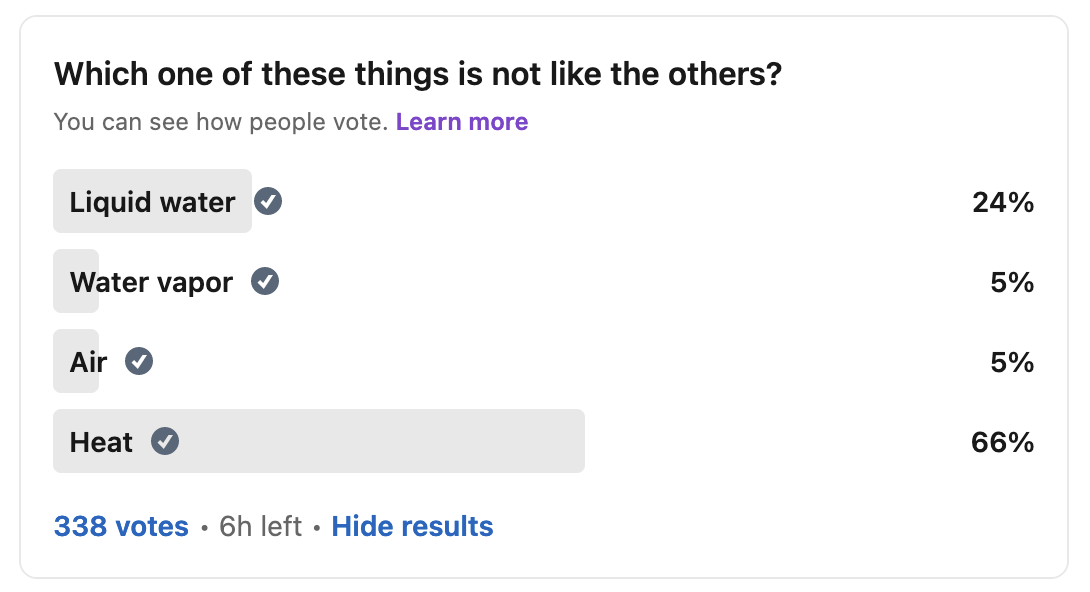
Controlling the flows of heat, air, and moisture is where building science begins. This is so important that I devoted more than a third of my book to the building enclosure and the four control layers. As much as I love discussing mechanical systems, the building enclosure comes first. So today, let’s have some control layer fun by playing a little game of “Which one of these is not like the other?”
The four control layers
I mentioned above only three things to control with the building enclosure: heat, air, and moisture. But actually there are four. That’s because moisture comes in two forms: liquid and vapor. I’m ignoring solid (ice) dihydrogen monoxide, i.e. water, because if you handle the others properly, it shouldn’t be a problem.
Here are the four things we want the building enclosure to control, along with some of the names of the control layer components:
- Liquid water – drainage plane, water-resistive barrier (WRB), flashing, water control layer
- Air – air barrier, air control layer
- Water vapor – vapor retarder, vapor barrier, vapor control layer
- Heat – insulation, thermal control layer
Proper choice of materials is critical, as is good installation of the control layers. And understanding that you also need the air and thermal control layers in alignment. That is, they need to be touching each other or built into the same material. Air permeable insulation (e.g., fiberglass, cellulose, mineral wool) loses thermal resistance if air moves through it, so it needs to be right next to the air barrier. In a wall cavity, it also should be fully encapsulated.
Of the four control layers, though, one of these is not like the others.
Which one of these is not like the others?
I posted this question on LinkedIn recently. Here are the nearly final results:

Now, you could make an argument for any one of those being the right answer. For example:
- Liquid water is the most important because it causes the most problems. As Canadian building scientist Gus Handegord said, “The three biggest problems in buildings are water, water, and water.”
- Air can carry heat, water vapor, and pollutants, so it’s a triple threat.
- Heat is energy; the other three are forms of matter.
But you can tell by its absence that water vapor was my choice. Why? Because we always need control layers for liquid water, air, and heat. We often don’t want to reduce the ability of water vapor to move through the building enclosure, especially in the more moderate climates. That prevents materials and assemblies from being able to dry out.
Bill Rose, in his excellent book, Water in Buildings, said it well:
“When design emphasis shifts to improved drying potential, vapor retarders will not be recommended.”
And that shift has happened.
A surprising result
In the prelude to the poll, I wrote that I was thinking about “buildings and building enclosures and control layers.” I thought I’d given away so much with that line that a lot of people would choose water vapor. As you can see from the results above, however, I was wrong.
Another reason the low number of votes for water vapor surprised me is that the answer is on page 67 of my book. After listing the four control layers, I wrote:
One of those four, however, is not like the others. Building codes require building enclosure control layers for liquid water, air, and heat in every climate. Using vapor retarders to control water vapor moving through the building enclosure, though, isn’t generally required in warmer climates.
But as I said before, you can make the case for any of the four being the outlier. As long as you understand the building science of heat, air, and moisture, it doesn’t matter which one you argued for. But what you really should remember is that a building’s ability to dry is really important.
____________________________________________________________________
Allison A. Bailes III, PhD is a speaker, writer, building science consultant, and the founder of Energy Vanguard in Decatur, Georgia. He has a doctorate in physics and is the author of a bestselling book on building science. He also writes the Energy Vanguard Blog. For more updates, you can subscribe to Energy Vanguard’s weekly newsletter and follow him on LinkedIn. Images courtesy of author.
Weekly Newsletter
Get building science and energy efficiency advice, plus special offers, in your inbox.















2 Comments
I initially thought of heat as being the outlier, but agree that context is the key after reading the explanations.
Really interesting article.
As someone new to building science, I appreciate how this article breaks down the four control layers in an accessible way. The poll results were surprising - I would have expected more people to choose water vapor as the outlier. If you're planning to write or review more about green building practices, I recommend checking out the https://stateofwriting.com/uk/book-review-writing-service . They can help you articulate your thoughts and insights in a polished manner so all your writings will look perfect!
Log in or create an account to post a comment.
Sign up Log in